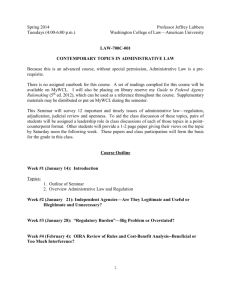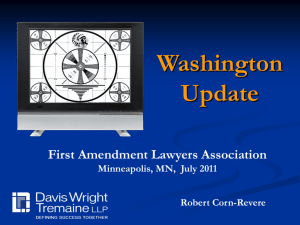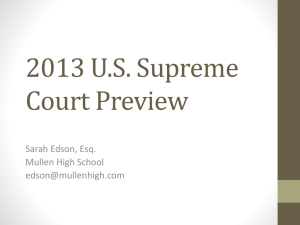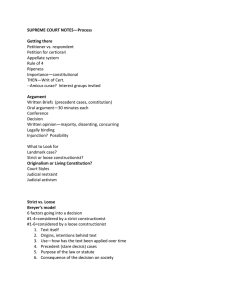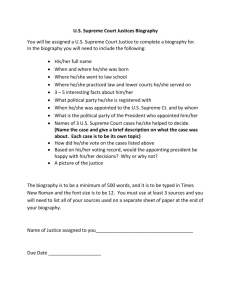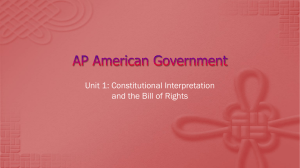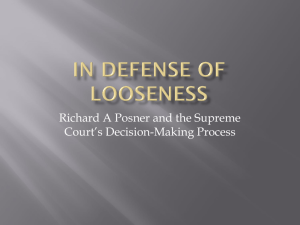+ 2 (,1 1/,1(
advertisement
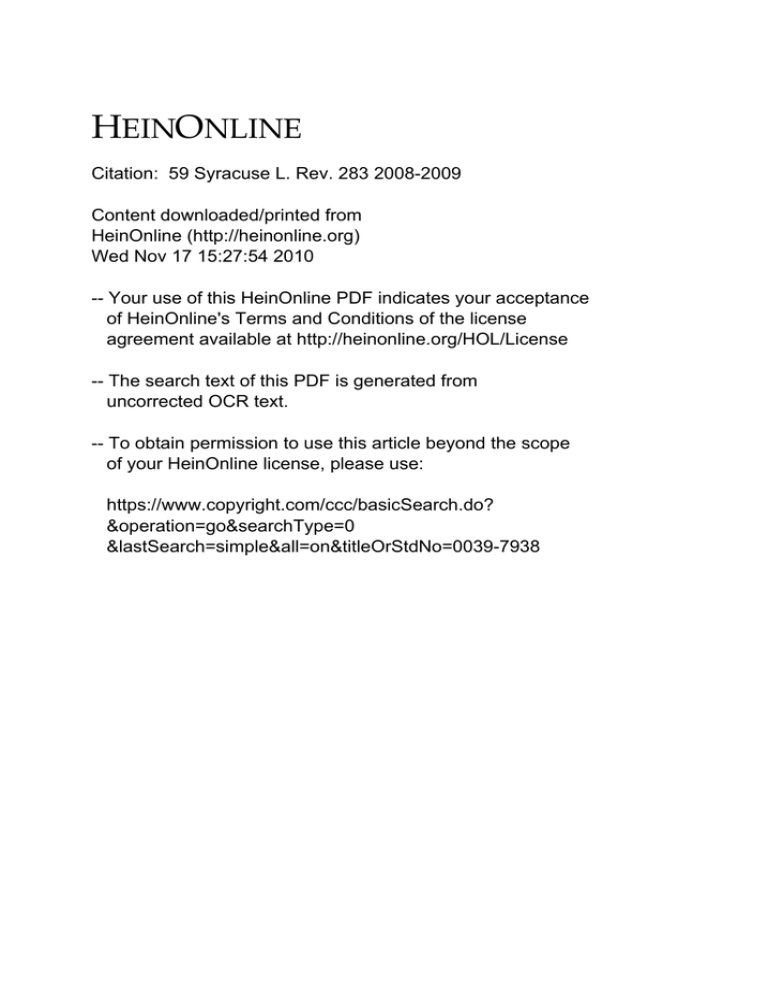
+(,121/,1( Citation: 59 Syracuse L. Rev. 283 2008-2009 Content downloaded/printed from HeinOnline (http://heinonline.org) Wed Nov 17 15:27:54 2010 -- Your use of this HeinOnline PDF indicates your acceptance of HeinOnline's Terms and Conditions of the license agreement available at http://heinonline.org/HOL/License -- The search text of this PDF is generated from uncorrected OCR text. -- To obtain permission to use this article beyond the scope of your HeinOnline license, please use: https://www.copyright.com/ccc/basicSearch.do? &operation=go&searchType=0 &lastSearch=simple&all=on&titleOrStdNo=0039-7938 THE LAST PROGRESSIVE: JUSTICE BREYER, HELLER, AND "JUDICIAL JUDGMENT" Richard Schragger t CONTENTS IN TRO D UCTION .......................................................................................... 283 285 I. PROGRESSIVISM AND ORIGINALISM ............................................... II. EXTRAPOLATING FROM THE CORE AND EXERCISING JUDGMENT .. 290 THE LAST PROGRESSIVE? ................................ . .. . . .. . . . .. . . . .. . . .. . . . . .. . . .. 294 C O NCLU SIO N ............................................................... 297 III. INTRODUCTION The historical meaning of the Second Amendment is at the center of the judicial debate in District of Columbia v. Heller.' Justice Scalia-in the majority opinion striking down Washington, D.C.'s handgun bandevotes almost twenty-nine pages of his thirty-five page opinion to the meaning of the various clauses of the Second Amendment to the yeoman farmers, jurists, and legal scholars of the new republic. 2 Justice Stevens, writing in dissent, uses approximately eighteen pages (in a twenty-fivepage dissent) to provide a historical counter-narrative. 3 This debate is whether the Second Amendment protects the citizens' right to bear arms in the context of militia service or whether it protects an individual right to bear arms in the context of self-defense. 4 As historians tell us, the meaning of the Second Amendment is complicated; historical claims 5are never as categorical as the two sides of a legal argument would have it. t Professor of Law, Class of 1948 Professor in Scholarly Research in Law, University of Virginia School of Law; Visiting Professor, NYU School of Law, Fall 2008; Samuel Rubin Visiting Professor of Law, Columbia Law School, Spring 2009. Many thanks to Jim Ryan, Richard Primus, Mark Tushnet, and especially Risa Goluboff for reading previous drafts. 1. 128 S. Ct. 2783 (2008). 2. See id. at 2788-2817. 3. See id. at 2824-42 (Stevens, J., dissenting). 4. Id. at 2789. 5. See, e.g., David Thomas Konig, The Second Amendment: A Missing Transatlantic Contextfor the HistoricalMeaning of "The Right of the People to Keep andBear Arms, " 22 LAW & HIST. REV. 119, 139, (2004); Paul Finkelman, "A Well Regulated Militia": The Second Amendment in HistoricalPerspective, 76 CHI-KENT L. REV. 195, 225-35 (2000). See also Akhil Reed Amar, The Bill of Rights and the Fourteenth Amendment, 101 YALE HeinOnline -- 59 Syracuse L. Rev. 283 2008-2009 Syracuse Law Review [Vol. 59:283 Justice Breyer, in dissent, excuses himself from the debate. 6 Breyer assumes for purposes of his argument that the Second Amendment protects an individual right to self-defense-as the majority claims. 7 He then proceeds to ask whether the District of Columbia's gun regulation is "unreasonable or inappropriate in Second Amendment terms." 8 To make that determination, he adopts a fact-based analysis-a constitutional test that involves explicitly balancing "the interests protected by the Second Amendment on one side and the governmental public-safety concerns on the other, the only question being whether the regulation at issue 9 impermissibly burdens the former in the course of advancing the latter." Although he refers in places to historical sources, Justice Breyer's primary concern is to understand the character of the government regulation, its purposes, and effects. He thus discusses studies and statistics concerning handgun violence and weighs the benefits and burdens of the District's handgun ban in relation to the majority's Second Amendment principle of self-defense.10 In the end, he judges the gun ban to be a valid exercise of the District's police power. II This paper considers Justice Breyer's dissent as a species of progressive jurisprudence. By progressive, I do not mean a political program but rather an approach to how the Supreme Court views its role and its work. Progressive jurisprudence was developed in the shadow of the relative formalism of the classical jurists and forged in the pragmatic philosophical tradition at the turn of the century.1 2 Progressive judges eschewed absolutist constitutional claims; their decisions were fact-based, attentive to changing social conditions, and deferential to legislatures. The progressive attitudecontext-specific, non-categorical, expertise-driven, and infused by a common law sensibility-is what Breyer means when he writes in his Heller dissent 3 that answering constitutional questions "requires judgment."' L.J. 1193, 1261-62, (1992). 6. See Heller, 128 S. Ct. at 2847 (Breyer, J., dissenting). 7. Id. (Breyer, J., dissenting). 8. Id. (Breyer, J., dissenting). 9. Id. at 2852 (Breyer, J., dissenting). 10. See id. at 2854-68 (Breyer, J., dissenting). 11. See id. at 2861 (Breyer, J., dissenting). 12. See, e.g., Thomas C. Grey, Modern American Legal Thought, 106 YALE L.J. 493, 495-98 (1996) (book review). For discussions of progressivism, see generally EDWARD A. PURCELL, JR., BRANDEIS AND THE PROGRESSIVE CONSTITUTION: ERIE, THE JUDICIAL POWER, AND THE POLITICS OF THE FEDERAL COURTS IN TWENTIETH-CENTURY AMERICA (2000); DANIEL T. RODGERS, ATLANTIC CROSSINGS: SOCIAL POLITICS IN A PROGRESSIVE AGE (1998); OTIS L. GRAHAM, JR., AN ENCORE FOR REFORM: THE OLD PROGRESSIVES AND THE NEW DEAL (1967); ROBERT H. WIEBE, THE SEARCH FOR ORDER 1877-1920 (1967). 13. Heller, 128 S. Ct. at 2868 (Breyer, J., dissenting). HeinOnline -- 59 Syracuse L. Rev. 284 2008-2009 2008] Breyer, Heller, and "Judicial Judgment" The nature of the exercise of that judgment and its relative transparency is at the heart of the methodological debate between Scalia and Breyer in Heller. That debate is as sharp as the debate over substance. Judgment of the kind that Justice Breyer talks about in Heller is the last thing that the 14 majority (and especially Justice Scalia) would have the Court exercise. Breyer-esque judicial judgment has come under sharp criticism for being too indeterminate, too fact-intensive, and too value-laden. By contrast, Justice Scalia's originalism is understood by its defenders as a remedy for the "standardless" discretion that Breyer's Heller opinion represents. Indeed, the judicial approach embodied by the Progressives has been in decline for some time, for it comes from a conception of the judge that is not copacetic with two twentieth century jurisprudential trends. The first trend is the idea that rights should be understood as trumps, defined in opposition to the public interest. Breyer's inclination to explicitly balance interests is uncongenial to this view-as a result libertarians on the left and the right are often unsatisfied with his conclusions. The second trend is a pervasive skepticism that legislatures or courts do or can ascertain and implement the public interest in the first place. This skepticism has generated repeated efforts to "cabin" judicial discretion out of a concern that judges are simply engaging in politics by another name. Scalia is deeply skeptical of legislative or judicial attempts to arrive at an honest assessment of the public good. Breyer is less so; the "problem" of judicial power that originalism attempts to solve is simply less of a concern for him. I. PROGRESSIVISM AND ORIGINALISM Progressivism is a slippery term, though its timing as a social and political movement in the early part of the twentieth century is well established. 15 Scholars have found the origins of a progressive jurisprudence in philosophical pragmatism as practiced by William James and John Dewey; in some aspects of the White and Taft Courts; and in the jurisprudence of Louis Brandeis, Benjamin Cardozo, and Oliver Wendell Holmes, Jr. 16 As Charles Haar and Michael Allen Wolf have observed, 14. Heller, 128 S. Ct. at 2818. 15. See e.g., Daniel T. Rodgers, In Search of Progressivism, 10 REVIEWS IN AM. HIST. 113, 113-14 (1982). 16. See William E. Forbath, The White Court (1910-1921): A Progressive Court?, in THE UNITED STATES SUPREME COURT: THE PURSUIT OF JUSTICE 172, 172-98 (Christopher Tomlins ed., 2005); G. EDWARD WHITE, THE CONSTITUTION AND THE NEW DEAL 273-75 (2000); G. EDWARD WHITE, JUSTICE OLIVER WENDELL HOLMES: LAW AND THE INNER SELF, 378-411 (1993); Charles M. Haar & Michael Allan Wolf, Euclid Lives: The Survival of Progressive Jurisprudence, 115 HARV. L. REV. 2158, 2160-61 (2002). Cf. STEPHEN BREYER, ACTIVE LIBERTY: INTERPRETING OUR DEMOCRATIC CONSTITUTION, HeinOnline -- 59 Syracuse L. Rev. 285 2008-2009 18-20 (2005) 286 Syracuse Law Review [Vol. 59:283 progressive jurisprudence appeared during the "crucial transition between a legal system dominated by the common law and one characterized by the growth of the administrative state." 17 They note a number of characteristics: an appreciation of the contextual nature of modem regulatory law; respect for the common law methodology and its ability to respond and adapt to societal change; deference to professionals and an appreciation of expertise; respect for state and local experimentation; attention to both the burdens and the benefits of government regulation; ' 18 and the "belief in the positive potential of government." Justice Breyer is undoubtedly a creature of the political and jurisprudential context of the late twentieth century, but his general approach to judging has many affinities to progressivism. Commentators have noted Breyer's pragmatism,1 9 and many of the themes of a progressive jurisprudence have appeared in Breyer's recent monograph, Active Liberty, written in part to respond to the rise of textualism and originalism. 20 It is no accident that Breyer liberally quotes Brandeis and Holmes in that book; Breyer's sense of the appropriate "attitude" toward judging--"an attitude that hesitates to rely upon any single theory or grand view of the law, of interpretation, or of the Constitution" but that is not afraid to use common law tools to determine how the Constitution should apply to "new subject matter ... with which the framers were not familiar"-reflects a progressive sensibility. 21 We have seen this sensibility in a number of recent Breyer opinionshis concurring opinion in Van Orden v. Perry,22 the Ten Commandments case; his dissent in Zelman v. Simmons-Harris,23 the school vouchers case; and his dissent in Eldred v. Ashcroft,2 4 which decided the constitutionality of Congress's extension of the copyright term. In each of these cases, (quoting Holmes and Brandeis on judicial modesty); Michael W. McConnell, Active Liberty: A Progressive Alternative to Textualism and Originalism?, 119 HARv. L. REV. 2387, 2389 (2006) (book review) (noting that "Breyer advocates a more 'modest' judicial role, in the tradition of Justices Brandies, Holmes, and Frankfurter"). 17. Haar & Wolf, supra note 16, at 2197. 18. Id. at 2174-75. 19. See, e.g., Paul Gewirtz, The PragmaticPassion of Stephen Breyer, 115 YALE L.J. 1675, 1677 (2006) (book review); Richard A. Posner, Justice Breyer Throws Down the Gauntlet, 115 YALE L.J. 1699, 1715-16 (2006) (book review); James E. Ryan, Does It Take a Theory? Originalism, Active Liberty, and Minimalism, 58 STAN. L. REv. 1623, 1643-44 (2006) (book review); Cass R. Sunstein, Justice Breyer's Democratic Pragmatism, 115 YALE L.J. 1719, 1719-20 (2006) (book review). 20. See generally BREYER, supra note 16. 21. Id. at 18-19. 22. 545 U.S. 677, 698-706 (2005) (Breyer, J., concurring). 23. 536 U.S. 639, 717-29 (2002) (Breyer, J., dissenting). 24. 537 U.S. 186, 242-69 (2003) (Breyer, J., dissenting). HeinOnline -- 59 Syracuse L. Rev. 286 2008-2009 2008] Breyer, Heller, and "Judicial Judgment" 287 Justice Breyer sought to understand the constitutional principle at issue through a close examination of the relevant government conduct, its to Richard context, and its practical effect. In this respect, Breyer is similar 25 Posner, the most vocal and prominent of the pragmatist judges. In Heller, we see this approach deployed in its cleanest form-unlike the First Amendment, the Second Amendment came to the Court with relatively little precedential baggage. And in Heller, Breyer is more explicit about defending his approach. He assumes self-defense as a core commitment of the Second Amendment but argues that the character of the legislation matters in defining the right: its purpose, its scale, its location, its effects, and its consequences. 26 For Breyer, defining the right to bear of the character and nature of the arms requires an understanding 27 regulation. governmental Approaching rights through an examination of governmental powers is not new. As Howard Gillman and others have argued, the classical jurisprudence of the late nineteenth century was also less preoccupied with the contours of any particular right than with the scope of legitimate government power.2 8 The classical court determined the limits of legal regulation by assessing the legitimacy of the ends being pursued by the government. Concerned with class legislation, the classical court would ask whether a piece of legislation promoted the good of the public or was 29 designed to promote the special interests of some favored group. Classical determinations were categorical; either the legislation did or did not promote the public interest. If it did not, the regulation invaded a protected right. The progressives challenged classical jurisprudence's categorical approach and expanded the notion of the public good when defining the limits of the police power. As Willy Forbath has written, the White Court not infrequently "mustered a majority behind an opinion by Holmes or Brandeis reminding the lower courts that property rights and liberty of contract were not absolutes and could not restrain government from 25. See, e.g., RICHARD A. POSNER, LAW, PRAGMATISM, AND DEMOCRACY 1 (2003); Richard A. Posner, Forward:A PoliticalCourt, 119 HARV. L. REV. 31, 90-91 (2005). 26. Id. at 2847-48 (Breyer, J., dissenting). 27. Id. at 2851-52 (Breyer, J., dissenting). 28. See, e.g., HOWARD GILLMAN, THE CONSTITUTION BESIEGED: THE RISE AND DEMISE OF LOCHNER ERA POLICE POWERS JURISPRUDENCE 61-62 (1993) [hereinafter CONSTITUTION BESIEGED]; Howard Gillman, Preferred Freedoms: The Progressive Expansion of State Power and the Rise of Modern Civil LibertiesJurisprudence,47 POL. RES. Q. 623, 639-40 (1994) [hereinafter PreferredFreedoms]. 29. See, CONSTITUTION BESIEGED, supra note 28, at 58-60. HeinOnline -- 59 Syracuse L. Rev. 287 2008-2009 288 Syracuse Law Review [Vol. 59:283 addressing 'all the great public needs."' 3 0 Recall that Village of Euclid v. Ambler Realty Co. 3'-which upheld a local zoning ordinance that significantly reduced the value of the land-owner's parcel-was decided in the midst of Lochner-eraabsolutism. 32 Comparing the Court's approach to property rights and gun rights is thus instructive. Indeed, the contours of the constitutional right of property have long been defined by balancing harms and benefits. 33 The core common law notion was and continues to be that property owners have no right to commit a nuisance. Defining the constitutional right of property has thus often entailed an implicit or explicit analysis of the harm-preventing purposes of the government regulation or statute. 34 One cannot understand the right of property independent of the government action that presupposes its assertion. The idea that rights are to be defined in relationship to a government interest is a commonplace of progressive jurisprudence. It is that inquiry that seems to animate cases like Euclid; it is further reflected in Brandeis's notion, articulated in Pennsylvania Coal Co. v. Mahon,35 that constitutional rights need to be understood in the context of the complex regulatory environment required for living in an interdependent, modem community. It is also the notion of rights that Breyer adopts in Heller, when he examines the harm-preventing justifications offered by the District to support its handgun ban. This explicit examination of the purposes of the legislation is anathema to Justice Scalia and the majority, however. The majority opinion is unequivocal: the paradigm of the Second Amendment right to bear arms is the ability to possess a readily useable handgun in one's home. 36 One does not look at the District's regulation to determine the bounds of the legitimate police power; one does not weigh burdens and benefits. Instead, the judicial articulation of the paradigm case-the core of the right-entails figuring out the historical purpose of the constitutional 30. Forbath, supra note 16, at 197. 31. 272 U.S. 365, 384-85 (1926). See also Haar & Wolf, supra note 16, at 2167 (citing Euclid, 272 U.S. at 384-85). 32. See Haar & Wolf, supra note 16, at 2158 (using Euclid as their key example of progressive jurisprudence); but cf Richard H. Chused, Euclid's Historical Imagery, 51 CASE W. RES. L. REV. 597 (2001) (observing that Euclid is replete with racial overtones). 33. For a discussion of how "balancing" begins in the progressive era, see Alex Aleinikoff, ConstitutionalLaw in the Age of Balancing, 96 YALE L.J. 943, 948-63 (1987). See also MORTON J. HORWITZ, THE TRANSFORMATION OF AMERICAN LAW 1870-1960: THE CRISIS OF LEGAL ORTHODOXY 18-19 (1992). 34. See, e.g., Miller v. Schoene, 276 U.S. 272, 279 (1928). 35. 260 U.S. 393, 413 (1922). 36. Heller, 128 S. Ct. at 2817-18. HeinOnline -- 59 Syracuse L. Rev. 288 2008-2009 2008] Breyer, Heller, and "Judicial Judgment" 289 right and protecting it unequivocally. 37 The method involves looking to historical sources to determine the constitutional provision's basic principle and then figuring out whether the case at issue falls within the core of that principle. In this, Heller looks a lot like another one of Justice Scalia's majority opinions: Lucas v. South Carolina Coastal Council,38 decided in 1992. Lucas is a takings case, involving the question of whether a state environmental regulation that prevented land owners from building on beach-front property constituted a per se taking of property requiring compensation. Prior to Lucas, the Court had in most instances determined whether a regulatory taking occurred by applying the three-part test adopted in Penn Cent. Transp. Co. v. City of New York.39 Penn Central has many of the characteristics of progressive jurisprudence: it requires courts to assess the character of the governmental action, the degree of infringement on the asserted right, and the regulation's interference with the property owner's reasonable expectations. 40 A taking is less likely to be found "when interference [with property] arises from some public program adjusting1 the benefits and burdens of economic life to promote the 4 common good.", In Lucas, Scalia rejects Penn Central's multi-factored approach. Instead, as in Heller, Scalia deploys his historical methodology to generate a paradigm case. Lucas holds that a regulation of property that eliminates the property's economic value is exactly what the Takings Clause was intended to address. 42 That principle should be applied to Lucas's property regardless of the purposes of the government regulation, regardless of the harm the government regulation is intended to address, and despite the fact that the category of regulatory takings itself had been invented by the Court in 1922.43 Lucas establishes a per se rule derived from the Court's understanding of the core, historically-understood purpose of the Takings 44 Clause. More importantly, the Lucas majority rejects any judicial assessment of the public good. Justice Scalia's opinion observes that one cannot make a non-political, non-value-laden distinction between harm-preventing and 37. See id. at 2817-18. 38. 39. 40. 41. 42. 43. 44. 505 U.S. 1003 (1992). 438 U.S. 104, 124-25 (1978). Id. at 124-125; see also Kaiser Aetna v. United States, 444 U.S. 164, 175 (1979). Penn Central,438 U.S. at 124. Lucas, 505 U.S. at 1030. See Pennsylvania Coal, 260 U.S. at 413. Lucas, 505 U.S. at 1030-3 1. HeinOnline -- 59 Syracuse L. Rev. 289 2008-2009 290 Syracuse Law Review [Vol. 59:283 benefit-conferring regulations. 4 5 He thus explicitly rejects a judicial approach that derives the content of rights by asking about the legitimacy of the exercise of powers-the approach used by classical jurists to delineate the contours of the police power and used by progressives to weight benefits and burdens. 46 In Lucas (and we see this again in Heller), considerations of degree or the weight of the community interests are not to be determined by legislatures or judges, but are only to be understood in their historical context. Thus, if eighteenth century nuisance law would have barred a particular use of property, twentieth century legislation can do the same. In this way, Scalia defines the core of the right, and then tells lower courts to look to historical understandings to figure out how it operates in practice. 4 7 Scalia strongly implies that current land use regulations that eliminate a property's market value-whatever their purpose-will only pass muster if they have historical analogs. Heller does the same, implying that current gun control regulations will only pass 48 muster if they too have historical analogs. II. EXTRAPOLATING FROM THE CORE AND EXERCISING JUDGMENT One benefit of originalism, according to Scalia and some of its other defenders, is that it promises determinacy. To the extent that extrapolation from the historically-determined core purpose of a constitutional provision is necessary, that extrapolation will be limited. Breyer disagrees. As already noted, Breyer assumes for purposes of his argument that the majority is correct that the core purpose of the Second Amendment is to protect an individual right of self-defense. But that core principle is just the beginning of the inquiry for Breyer, not the end. The key question for Breyer is: "Given the purposes for which the framers enacted the Second Amendment, how should it be applied to modem-day circumstances that they could not have anticipated?" 49 Finding the historical core (a difficult first step in itself) and then extrapolating is one way to do so. But the extrapolation has to happen, and Breyer's claim is that history is only going 50 to get you so far. It is here that Breyer wants to introduce "judgment-judicial judgment exercised within a framework for constitutional analysis that 45. See id. at 1025. 46. Id. at 1024. 47. Lucas, 505 U.S at 1025. 48. See Heller, 128 S. Ct. at 2797. 49. Id. at 2870 (Breyer, J., dissenting). 50. See id. at 2868. HeinOnline -- 59 Syracuse L. Rev. 290 2008-2009 2008] Breyer, Heller, and "Judicial Judgment" guides that judgment and which makes its exercise transparent."5 1 The "framework" to which Breyer is referring is a standard of review. In Heller, Breyer assumes that strict scrutiny is the appropriate test, but notes that the protection of public safety has always been considered a compelling government interest. 52 Regulating an inherently dangerous weapon is certainly harm-preventing. The question for Breyer is thus whether the regulation burdens the right out of proportion to that interest 53 means. alternative restrictive less are there whether and Standards of review are useful because they force good-faith decision makers to approach a problem with a particular non-substantive frame of mind. But standards of review or tiers of scrutiny are also an acknowledgement that the institutional relationship between courts and legislatures often determines the content of judicially-enforceable rights. That is, it is an implicit acknowledgement that the answer to a constitutional question may turn on a meta-decision about the division of labor between courts and legislatures or judges and fact-finders. By categorizing at the outset those subject areas that will receive particular scrutiny, the Court signals when it will exercise power and when it will not. We have less need for standards of review, however, if the Constitution consists of clearly demarcated rules. One does not need to articulate a judicial approach to a right that is perspicuous on its face or, more specifically, on the face of the historical record. For this reason, the majority does not engage in the standards inquiry. According to the majority, once the core of the right is discovered through the careful parsing of the Constitution's text and the historical record, it can be applied directly. 54 In this way, Justice Scalia's paradigm-enforcing form of originalism itself is meant to solve the problem of the institutional nature of constitutional interpretation. Justice Scalia has long maintained that the Constitution is composed of per se rules (here is Lucas again) that can be relatively easily understood and applied. 55 When judges enforce the rules laid down they are not doing anything that requires special expertise or the exercise of Breyer-esque "judgment." It is here that Justice Breyer's critique is trenchant, for he shows how "judgment" squeezes itself between the lines of the majority's favored eighteenth century texts. Initially, he notes that determining the historical core itself involves judicial choices-choices that are obscured by the 51. 52. 53. 54. 55. Heller, 128 S. Ct. at 2870 (Breyer, J., dissenting). Id. at 2851 (Breyer, J., dissenting). Id. at 2852 (Breyer, J., dissenting). Seeid.at2821. See id. at 2821; Lucas 505 U.S. at 2892-93. HeinOnline -- 59 Syracuse L. Rev. 291 2008-2009 Syracuse Law Review [Vol. 59:283 majority's claim simply to be uncovering history.56 This criticism of originalism is familiar, of course. If the historical record is mixed or somewhat ambiguous, then one is going to have to make some controversial choices about which historical route to take. Moreover-and this is more important-Breyer observes that the application of a historically-determined core to new circumstances requires a number of controversial moves that ask the court to do the balancing that it professes to be avoiding. 57 First, the majority in Heller has to decide whether the right to bear arms in self-defense is of such generality that it can be applied to modem circumstances or whether it is restricted to its eighteenth century context. The right to "drive a horse and buggy" could be enforced today, but it would have fairly limited applicability. So would a right to bear arms in a state-regulated militia. Once the majority determines that the Second Amendment principle is of a higher generality, Scalia has little trouble with this aspect-applying that principle to modem technologies is easy. But this cannot be taken for granted. Scalia observes that the argument that the Second Amendment only applies to weapons in existence in the eighteenth century "border[s] on the frivolous" -but that is only because the right has8 been described at his preferred level of 5 generality in the first place. Second, the majority has to figure out how the right applies to circumstances that did not exist at the time, i.e., handguns when there were few handguns, large cities when there were only a few small cities, a professional police force when there was none. It is not obvious that an ordinance banning handguns invades the core of the Second Amendment right of self-defense when long guns and other forms of defensive arms are still permitted, or when a professional police force is available to protect citizens' persons and property.59 Why are handguns in the core when one can legally own a shotgun? And conversely, why does the right extend to handguns but not to automatic weapons? One needs a theory and Scalia provides it: the right to self-defense requires that citizens be permitted to use the currently most popular and useable weapon for self-defense. 60 This claim is not at all obvious, however. As Justice Breyer points out, the relative popularity of a weapon is not an argument for why it must be protected. 6 ' Such a claim is not supportable by historical fact; it is an 56. See Heller, 128 S. Ct. at 2869. 57. 58. 59. 60. 61. Id. at 2853-54. Id. at 2791. See id at 2866 (Breyer, J., dissenting). Id. at 2817-18. Heller, 128 S. Ct. at 2869 (Breyer, J., dissenting). HeinOnline -- 59 Syracuse L. Rev. 292 2008-2009 2008] Breyer, Heller, and "Judicial Judgment" assertion about how the general principle of self-defense should be applied today considering all the relevant circumstances. To make the leap from the historical principle that the Second Amendment encompasses a right to bear arms for self-defense to its application to a modem handgun ban requires judgment about present circumstances. This judgment is present when the majority indicates that most gun control laws will survive despite the expansive right to self-defense it adopts in Heller.62 But why are laws regulating concealed weapons, machine guns, tanks, bazookas and other "unusual weapons;" requiring guns to be licensed; limiting felons, the mentally ill, and children from owning guns; and forbidding the carrying of firearms in sensitive buildings all outside the paradigmatic core? Scalia moves very quickly to embrace these common regulations, implying that they are historically warrantedthough without much evidence at all, historical or otherwise. 63 It is the same move he makes in Lucas, where he allows for "traditional" nuisance 64 regulations, but does not specify the historical basis for any particular one. The majority opinion also does not tell us what should happen in the absence of historical analogs, an absence that might illuminate the core Second Amendment right or may say nothing at all about it. As Justice Breyer points out, the absence of eighteenth century regulations does not indicate that the core right excludes such regulations-only that these issues did not come up. 65 We see this problem in the types of eighteenth century evidence offered by the majority and dissents. Breyer argues that the eighteenth and nineteenth century rules requiring gunpowder to be stored apart from guns (thus making those guns inoperable) indicate a narrow understanding of the Second Amendment or at least one in which 66 threats to public safety. the right to bear arms was balanced against 67 Justice Scalia dismisses those ordinances. Breyer's point in discussing eighteenth century fire codes is twofold. First, rights are always being defined against some background public safety concerns-they were in the eighteenth century and they are now. Second, relying on historical evidence of analogous regulations is fraught with judicial discretion. The historical record will rarely present a historical analog on point; to the extent there are regulations, deciding which ones count as analogous and which ones do not is arbitrary, and the 62. 63. 64. 65. 66. 67. Seeid. at 2816-17. See id. at 2817. Lucas, 505 U.S. at 1029. See Heller, 128 S. Ct. at 2868 (Breyer, J., dissenting). See id. at 2849-50 (Breyer, J., dissenting). Id. at 2819-20. HeinOnline -- 59 Syracuse L. Rev. 293 2008-2009 Syracuse Law Review [Vol. 59:283 absence of a regulation does not tell you a thing about the right. People in the eighteenth century simply did not have to grapple with the problem of urban handgun violence. On the other hand, people in the eighteenth century were being careless with gunpowder and creating a significant risk of fire. What do these historical facts tell us about the present-day contours of the right to bear arms? Not much. III. THE LAST PROGRESSIVE? Breyer argues that one has to assess the character of the legislative action to determine the present-day contours of the right. The nature of the right turns on whether the exercise of police power is out of proportion to an identifiable and important constitutional interest. 68 Balancing is unavoidable. Explicit judicial balancing, however, tends to conflict with two twentieth century jurisprudential trends. The first is the notion that rights are better conceived as trumps that exist despite and in opposition to utilitarian calculations of public interest. 69 The second is the view that determinations of public interest-the weighing of harms and benefits-is not and cannot be done by either courts or legislatures; indeed, that the public interest does not itself exist. As to the first, the idea of rights as dignitary- and autonomy-enforcing backstops to majority rule has appeal to both the political left and the political right. The goal has been to find a way to get the "right" rights without recourse to judges' personal preferences-a task that pragmatists like Holmes thought quite impossible. Preferred position, fundamental values, moral and political theory, and political process have been the 70 leading approaches to constitutional rights in the twentieth century. Originalism has been offered as a better way to dodge the "preferences" problem, though it does so by eschewing explanation. The majority opinion in Heller does not seek to articulate a constitutional, political, or moral theory that supports its particular conception of the Second 68. Cf id. at 49. 69. See Ronald Dworkin, Rights as Trumps in THEORIES OF RIGHTS, 153 (Jeremy Waldron ed., 1984) (arguing that "[r]ights are best understood as trumps over some background justification for political decisions that states a goal for the community as a whole"). 70. Carolene Products footnote 4 is the urtext for a number of these approaches. See United States v. Carolene Prod. Co., 304 U.S. 144, 152 n.4 (1938); JOHN HART ELY, DEMOCRACY AND DISTRUST (1980). Ronald Dworkin and John Rawls have been most closely associated with modes of interpretation that emphasize moral and political theory. See generally RONALD DWORKIN, LAW'S EMPIRE (1986); JOHN RAWLS, (1971). HeinOnline -- 59 Syracuse L. Rev. 294 2008-2009 A THEORY OF JUSTICE 2008] Breyer, Heller, and "Judicial Judgment" Amendment. Indeed, a substantive defense of the Second Amendment right would be incompatible with Scalia's commitment to be acting merely as the Founders' amanuensis. The majority argues that it can do nothing other than explain what the 7right to bear arms encompassed in the 1 eighteenth century and apply it. But this claim of "mere" application is a pretense, and it opens the majority up to Breyer's charge that the method lacks judicial transparency. 72 In large part that is because, like all constitutional theories that promise "neutrality," originalism depends on a host of substantive claims about the nature of constitutional interpretation, the nature and value of rights in general and this right in particular, and the nature of historical "truth"-all of which are submerged.73 The pretense of application also implies that there is no balancing going on. But the Supreme Court has never actually treated rights in the paradigmatic fashion. Rather, rights are the name given to very, very important interests-interests that can be overridden for a compelling reason. The right of free speech ends when there is a clear and present danger; the right of free exercise ends with the requirements of a generally applicable neutral law; the right of property does not encompass the right to engage in a nuisance or do harm to the community. The judiciary's job is to make those trade-offs explicit by articulating the competing interests clearly. It is thus obfuscation to pretend that the tradeoff is not taking place. Breyer admits that he is balancing-indeed, as he argues, one cannot do otherwise. 74 To the extent that he does so explicitly, Breyer's critique of the majority opinion as lacking transparency is right. The second challenge to a progressive jurisprudence is a skepticism about the content of the public interest-the hard-bitten attitude most associated with public choice theory concerning the capacity of legislatures and judges to arrive at a defensible and articulable account of the common good. That attitude tends to view legislative outcomes as products of interest-group politics and any judicial assessment of the character or nature of legislation as being tainted by similar political or policy "preferences." 75 Justice Scalia's argument in Lucas that judges cannot (and 71. SeeHeller, 128 S. Ct. at2821. 72. Id. at 2868 (Breyer, J., dissenting). 73. See RONALD DWORKIN, FREEDOM'S LAW 313-14 (critiquing the "neutrality thesis"). For critiques of originalism, see generally id.; Paul Brest, The Misconceived Quest for the Original Understanding,60 B.U. L. REV. 204 (1980); Daniel A. Farber, The Originalism Debate: A Guidefor the Perplexed,49 OHIO ST. L.J. 1085, 1087-97 (1989). 74. Heller, 128 S.Ct. at 2852 (Breyer, J., dissenting). 75. See STEVEN P. CROLEY, REGULATION AND PUBLIC INTERESTS: THE POSSIBILITY OF GOOD REGULATORY GOVERNMENT 29-34 (2007); id. at 281. HeinOnline -- 59 Syracuse L. Rev. 295 2008-2009 296 Syracuse Law Review [Vol. 59:283 should not) differentiate between harm-preventing and benefit-conferring legislation is a reflection of this view. 76 On this account, there is no independent, non-political institution that can ascertain the common good. Legislatures are not doing it and courts cannot (and should not) do it. Breyer simply does not understand this skepticism. He has no reason to believe that judges will not exercise their best judgment, and he relies on standards of review (with their built in deference to legislatures) and other 77 political process values to ensure that the judiciary acts within its bounds. He shares the progressive faith in open, non-partisan government and expertise-judicial or otherwise. In his view, one can make distinctions between "preferences" (legislative or judicial) and those decisions (legislative or judicial) that seek to embody the public interest or the common good. 78 The act of writing down one's reasoning, making the factors known, and being candid about one's considerations does much of the work of transparency. In Heller, Justice Breyer argues that the parties' competing interests can be thoughtfully canvassed and assessed. 79 The District's gun ban was limited to a particular sub-set of weapons, it was geographically targeted, responsive to a difficult and pervasive problem of urban crime and handgun violence, and proportional to the danger handguns pose. 80 Heller is an easy case in progressive terms. Indeed, the majority's dramatic redefinition of the police power in Heller, which implies that government regulation is limited to those regulations that existed in the eighteenth century, sounds positively crazy. Nevertheless, the majority's historical methodology and its extrapolation from the paradigm case appear very judicial. Why? Ironically, it is because this form of originalism offers to dispense with judges altogether, by eliminating or limiting the exercise of judicial judgment. This limiting of judicial judgment has been the holy grail of constitutional theory for some time, with its preoccupation with the counter-majoritarian difficulty. Breyer, however, is unconvinced that such judgment can be dispensed with. Better to make the competing policy interests apparent and assess each legislative regulation on its own terms. 76. See Lucas, 505 U.S. at 1026. 77. See Gewirtz, supra note 19, at 1689. 78. See BREYER, ACTIVE LIBERTY, supra note 16, at 120. See also CROLEY, supra note 75, at 100-0 1 (criticizing public choice theory's skeptical view of the regulatory state). 79. See Heller, 128 S. Ct. at 2852 (Breyer, J., dissenting). 80. See generally id. at 2854-68 (Breyer, J., dissenting). HeinOnline -- 59 Syracuse L. Rev. 296 2008-2009 2008] Breyer, Heller, and "Judicial Judgment" 297 CONCLUSION Justice Breyer's approach is both realist and optimistic. It is realist in that it views the exercise of judicial judgment as inevitable and unavoidable. It is optimistic because it is animated by a basic faith in judges' willingness and ability to exercise that judgment in good faith. These attitudes are out of fashion in the current political and judicial environment. Progressivism's pragmatism and faith in expertise and reason-giving have been replaced by a combination of post-modem skepticism and historical retrenchment. These two are strange bedfellows; what they share is a deep distrust of public reasoning and decision-making. One can assume that text and history are relevant tools in the judicial craft of constitutional interpretation. Justice Breyer certainly believes that defining constitutional rights requires some understanding of the original purpose of a constitutional provision. 8 1 But after determining the historical purpose or principle, what next? Constitutional provisions invariably are written at a level of generality that requires judgment in the application to present-day circumstances. Progressive jurisprudence attempts to do so within an institutional and regulatory context; it rejects per se or categorical rules; it defers to legislative expertise; and it engages in a good faith and honest weighing of benefits and burdens while paying a great deal of attention to the character and scope of the government regulation. This approach to judging is marginalized in Heller-the central debate among the justices concerns the history of the Second Amendment. Breyer's insistence that Supreme Court justices exercise "judicial judgment" in determining the contours of the right to bear arms is a distinctly minority view. 81. See BREYER, supra note 16, at 19. HeinOnline -- 59 Syracuse L. Rev. 297 2008-2009 * * * HeinOnline -- 59 Syracuse L. Rev. 298 2008-2009
